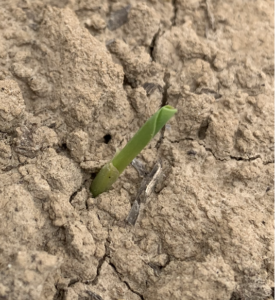#Plant23 is well underway. From the time seeds are sown, how many days should it take for crops to emerge? That can vary greatly, from days to weeks. But for many crops, it’s not really about calendar days, but Growing Degree Days (GDD). Take corn. Soil temperatures must be 50 degrees for corn to germinate (or spout). To penetrate above the two-inch layer of soil that seeds are typically planted in, corn relies on a heat index called Growing Degree Days. Corn needs about 120 GDDs to emerge. GDDs are calculated by adding the day’s high and low temperatures, dividing by 2, and subtracting 50 (for calculating purposes, 86 degrees is the maximum, 50 degrees is the minimum). So, if we hit 80 degrees for a high and 60 for a low, that gets us 20 GDDs. At this rate, you’d see corn up in less than a week. But in many areas of the Midwest, early spring weather can produce days with a high of 64 and lows in the 40s. That would generate only 7 GDDs. At that rate, you’re looking at about 2-1/2 weeks for emergence. GDDs also determine when plants mature. The hybrid I’m using on my high-yield farm, Agri-Gold 647-79, will reach maturity with 2,801 GDDs.
If there was a home makeover show for crops, the star would be soybeans. In just a short time, this once neglected legume is now the fancy of farmers across the Midwest and South. Fueled by a strong export market – one of every two rows of US soybeans is exported – soybean prices are high (over $15 in inland markets); production costs are much lower than competitive crops such as corn, cotton and rice; and yields are on a steep incline. Just look at the USA’s top producer, Illinois, where yields have risen dramatically – trending 15 bushels higher over the past ten years. Prairie State growers now average 64 bu/A. But it hasn’t always been that way. Soybeans have long been the proverbial stepchild, regarded as a mere “rotational” crop. Farmers would focus on getting their corn planted in a timely manner, then breathe a sigh of relief. The mindset was, “there’s plenty of time to get the beans in.” Nowadays, many growers are planting soybeans before corn, as they’re learning soybeans are not as delicate as they once thought, and there are yield benefits to early planting. It’s all about capturing more sunlight and getting the plants to reach the canopy sooner. Many large-sized growers even utilize two planters, dedicating one to soybeans. Population rates have also been fine-tuned. The popular belief once was to plant at a higher population; 165,000 seeds per acre was common. Now many progressive growers are dramatically reducing rates, some going below 100,000 seeds per acre. In addition to saving on seed costs, part of the philosophy is to better manage the structure of the plants, enabling them to create more branches and fruiting points. Fertility is another area that’s been overhauled. There was a common belief that soybeans produced their own nitrogen and could just scavenge for the rest of their nutrients. It was common for farmers in a corn/soy rotation to simply increase their levels of potash before planting corn – thus carrying over K to the next season – to avoid any application expense for their rotational crop. Adding micronutrients to soybeans was almost unheard of. Guided by tissue sampling, many soybean fields are now spoon-fed throughout the season with specialty fertilizers and biostimulants.
Regen Power Bars? They may be making their way to store shelves near you, courtesy of Kind Snacks. Following a recent commitment to sourcing 100% of its almonds from bee-friendly farms, the Mars-owned brand has launched the Almond Acres Initiative, a pilot dedicated to sourcing 100% of its almonds from orchards using regenerative agriculture by 2030. To celebrate, the brand is promoting its environmentally kind practices by partnering with Snapchat, creating the social media platform’s first-ever lens that takes users on a virtual visit to Almond Acres and where you can learn about regen ag. Kind wants their almonds grown using farming practices that contribute measurable benefits to the soil, the farm and the planet. Sounds like what humates do.
Friday is Cinco de Mayo. While it’s not celebrated south of the border near to the extent that it is in the USA, the holiday is an opportunity to recognize what’s arguably Mexico’s greatest contribution to agriculture: corn. The origins of maize can be traced back thousands of years to central Mexico and a wild grass called teosinte. This plant vaguely resembles today’s corn, featuring multiple branches that produce several small grain heads with small kernels. You might say the early Mexican natives were the first geneticists. They noticed that some plants grew larger than others and that specific plants produced seeds that tasted better or were easier to grind. By saving seeds from the more desired plants and planting them the following season, they employed selective breeding and artificial selection. As nomadic tribes migrated across the Americas, they brought this versatile crop with them. Christopher Columbus was said to have made the European discovery of corn and returned to Spain with a pocket full of corn seeds. Today, corn is a staple of Mexican diets. The average citizen eats nearly 400 pounds of corn each year (by comparison, the average American consumes 160 pounds), largely due to their love of tortillas and tamales. For that reason, corn is the most widely grown crop in Mexico. However, domestic farmers cannot meet demand. Mexico is the USA’s largest corn customer, buying $5 billion worth of maize annually. American farmers supply 95% of all Mexican corn imports.
Related Posts

20th Annual Commodity Classic
Come see us at the 20th Annual Commodity Classic at the Phoenix Convention Center in Phoenix, Arizona, on February 26–28. Alan Merrill and Johann Buck, PhD, will be there in Booth 1438 to answer all of your Huma Gro questions. For more information, go to www.commodityclassic.com.

Why Are Humic Substances Called Acids?
By Richard Lamar, PhD Senior Director of Humic Research Bio Huma Netics, Inc. We are accustomed to seeing humic substances (humic and fulvic) in dry/granular form, and we tend to think of acids as liquids. So why are humic and fulvic substances called acids? All substances, solid AND liquid, have a chemical makeup. An acid

This Week in Ag #52
What are farmers doing during these cold winter days? If they farm in the Midwest, they may be laying tile. I realize this may be a foreign concept to my friends in the west, but in many areas of the Corn Belt, you must often move water out of your fields. In heavier soils, excessive rainwater can remain


